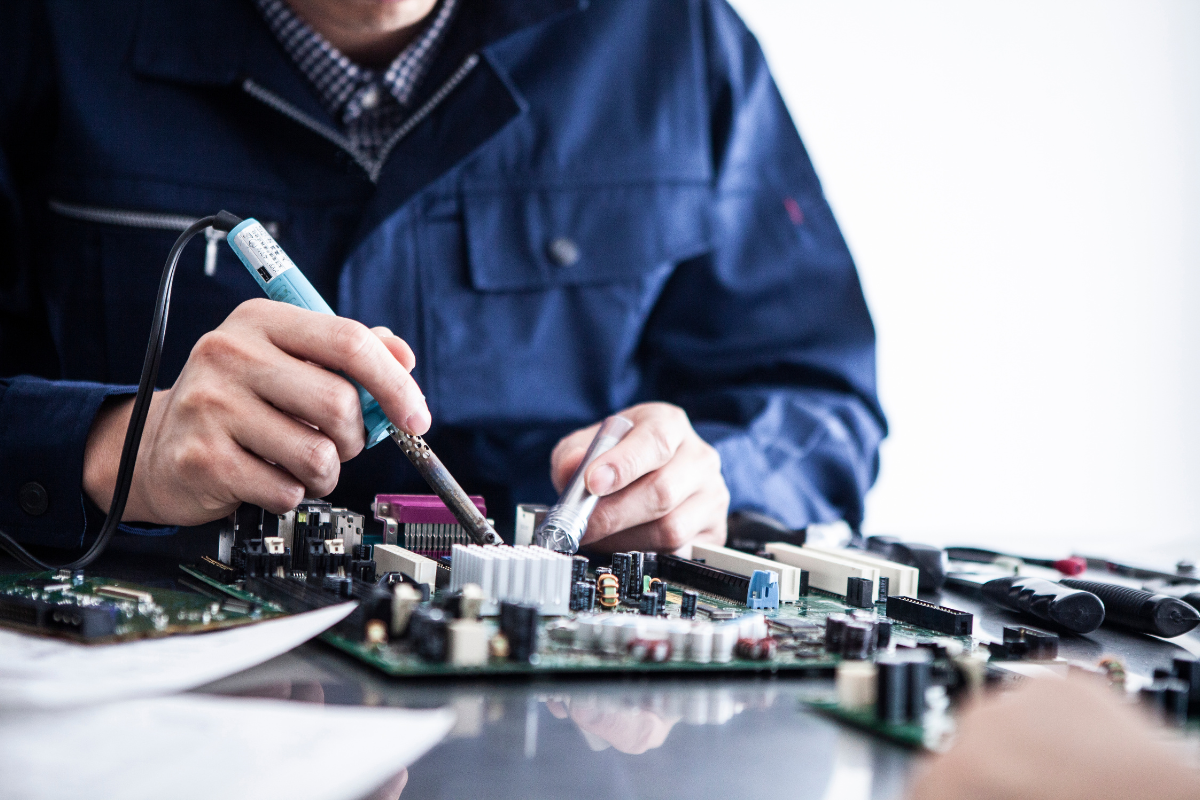In the electronics manufacturing industry, static electricity (Electrostatic Discharge or ESD) is a silent threat that can cause severe damage to sensitive components. Without Static Electricity Protection, its effects can impact product quality, workplace safety, and the company’s production costs. This article highlights the key reasons why ESD protection is essential in the electronics manufacturing industry and presents effective strategies for managing this issue.

1. Prevents Damage to Electronic Components (ESD: Electrostatic Discharge)
Electronic components such as microchips, integrated circuits (ICs), and semiconductors are highly sensitive to static electricity due to their delicate and intricate internal structures. The transfer of static charges from the human body or unprotected tools can cause visible damage or latent damage, which might not be immediately apparent. Such damage could result in malfunctioning components or permanent loss of efficiency. ESD-specific protective devices, such as antistatic mats, wrist straps, and tools with grounding systems, can significantly reduce these risks.
Additionally, monitoring the working environment to prevent the accumulation of static charges is essential. For instance, treating workbench surfaces to be antistatic or installing ionizers to balance the air’s charge can mitigate the risk of static charge transfer directly to electronic components.
2. Maintains Product Quality and Reliability
The quality of electronic products such as smartphones, computers, and household appliances depends on the integrity of their electronic components. Even minor damage caused by static electricity can affect the product’s long-term performance, such as circuit malfunctions, data processing errors, or unstable system connections. Controlling static electricity at every stage of the production process—from assembly to packaging and transportation—is critical to ensuring high-quality and reliable products.
Advanced technologies, such as static detection and alarm systems in production lines, can help prevent damage before components are used or shipped to customers. Furthermore, detailed failure analysis processes can identify the root causes of problems and enhance future control measures.
3. Reduces Financial Loss and Safeguards Company Reputation
Repairing or reproducing components damaged by static electricity can significantly increase a company’s costs. Additionally, defective products can lead to customer dissatisfaction and long-term damage to the brand’s reputation. Investing in ESD protection systems, such as establishing ESD Protected Areas (EPA) and training employees on ESD prevention measures, helps reduce risks and builds trust in the company’s products.
Considering the financial repercussions of potential damage, such as product recalls or compensating customers, serves as a major incentive for companies to prioritize ESD protection throughout the production process.
4. Creates a Safer Work Environment
In some cases, static electricity affects not only electronic components but also poses hazards to employees and equipment. For example, the accumulation of static charges in areas with flammable materials or gases can trigger sparks, leading to fires or explosions. Managing static electricity through appropriate control systems—such as using antistatic materials in high-risk areas, installing effective grounding systems, and regularly monitoring static levels—can prevent accidents and reduce risks in the workplace.
Raising employee awareness about safety is another critical strategy. Educating workers about the dangers of static electricity and ensuring adherence to safety protocols can minimize the risk of accidents and enhance overall workplace safety.
Guidelines for ESD Protection in the Industry
- Environmental Control: Maintain appropriate humidity levels in factories to reduce static charge accumulation.
- Use of Antistatic Equipment: Implement wrist straps, antistatic mats, and grounding-equipped tools.
- Employee Training: Educate workers on the dangers of ESD and methods to prevent it during operations.
- Equipment Maintenance and Inspection: Regularly check the efficiency of ESD protection systems and related equipment.
Adopting international standards such as ANSI/ESD S20.20 in manufacturing processes can further ensure the effectiveness of ESD protection systems in factories. It also helps companies comply with the requirements of global partners and customers.
ESD protection in the electronics manufacturing industry is essential for maintaining product quality and stability, preventing damage to electronic circuits, and minimizing defects in production processes. Investing in robust ESD control systems not only ensures product reliability but also safeguards the company’s financial stability and reputation in the competitive electronics market.








